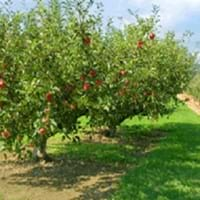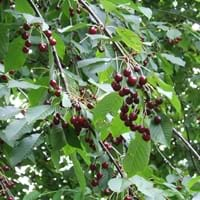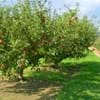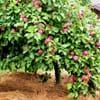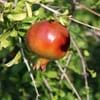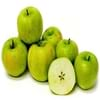Life Span
Perennial
Perennial
Origin
Eastern Europe, Southern Europe, Russia/Siberia, Southern Asia, Western Asia
Hybrid origin, Europe, Asia
Types
fuji, jonathan apple
Fruit
Habitat
Cold Regions, gardens
Temperate Regions
USDA Hardiness Zone
5-8
4-8
Sunset Zone
6, 7, 8, 9, 10, 14, 15, 16
A2, A3, 1a, 1b, 2a, 2b, 3a, 3b, 4, 5, 6, 7, 8, 9, 14, 15, 16, 17
Habit
Oval or Rounded
Upright/Erect
Flower Color
White, Light Pink
White
Flower Color Modifier
Bicolor
Bicolor
Fruit Color
Yellow, Red, Orange Red
Red, Dark Red
Leaf Color in Spring
Green
Dark Green
Leaf Color in Summer
Green
Dark Green
Leaf Color in Fall
Green
Dark Green
Leaf Color in Winter
Light Green
Light Green
Leaf Shape
Oval Cordate
Simple lobed or unlobed
Plant Season
Spring, Fall
Spring, Summer, Fall
Sunlight
Full Sun, Partial Sun, Partial shade
Full Sun, Partial Sun
Growth Rate
Medium
Medium
Type of Soil
Clay, Loam
Clay, Loam, Sand
The pH of Soil
Acidic, Neutral
Acidic, Neutral, Alkaline
Soil Drainage
Well drained
Well drained
Tolerances
Drought
Drought
Where to Plant?
Ground
Ground
How to Plant?
Grafting, Seedlings, Stem Planting
Semi-hardwood and hardwood cuttings
Plant Maintenance
Medium
Medium
Watering Requirements
Do not let dry out between waterings, Never Over-water, Use Mulches to help prevent water loss during hot and windy weather
Keep ground moist, Use Mulches to help prevent water loss during hot and windy weather
In Summer
Alternate Days
Lots of watering
In Spring
Moderate
Moderate
In Winter
Less Watering
Average Water
Soil pH
Acidic, Neutral
Acidic, Neutral, Alkaline
Soil Type
Clay, Loam
Clay, Loam, Sand
Soil Drainage Capacity
Well drained
Well drained
Sun Exposure
Full Sun, Partial Sun, Partial shade
Full Sun, Partial Sun
Pruning
Prune central stem, Remove lateral branches
Remove damaged leaves, Remove dead branches, Remove dead leaves
Fertilizers
Apply 10-10-10 amount, fertilize in growing season, Fertilize the soil before planting
All-Purpose Liquid Fertilizer
Pests and Diseases
Bacterial Blight, Bacterial Canker, Leaf rust, Red blotch, Ring Rot, Woodpecker feeding
Birds
Plant Tolerance
Rocky Soil, Shade areas
Drought
Flower Petal Number
Single
Single, Double
Foliage Texture
Medium
Medium
Foliage Sheen
Matte
Glossy
Attracts
Bees, Butterflies, Hummingbirds, Insects
Birds
Allergy
Peripheral Edema, Vomiting
Anaphylaxis, gastro-intestinal problems, Itchiness, Skin irritation
Aesthetic Uses
Cottage Garden, Showy Purposes
Beautification, Bouquets, Informal Hedge, Landscape Designing, Showy Purposes, Wild gardens
Beauty Benefits
Acne, For treating wrinkles, Improve skin tone, Moisturizing, Stops hair loss
Not Available
Environmental Uses
Food for animals, Shadow Tree, soil stabilisation, Windbreak
Air purification
Medicinal Uses
Acne, Alzheimer’s Disease, Anemia, constipation, Gastrointestinal disorders, Hair Loss, Parkinson
anti-inflammatory, Anti-oxidant, Gout, Insomnia, Soothing and relieving pain
Part of Plant Used
Fruits
Flowers, Fruits
Other Uses
Acts as a natural source of rain water for birds and insects., Cosmetics, Used As Food
Air freshner, Beneficial species for attracting pollinators, Cake, Edible syrup, Oil is used in perfume, soaps, creams, etc., Used to make juice
Used As Indoor Plant
No
No
Used As Outdoor Plant
Yes
Yes
Garden Design
Edible, Feature Plant, Fruit / Fruit Tree, Topiary / Bonsai / Espalier
Edible, Feature Plant, Fruit / Fruit Tree
Botanical Name
MALUS domestica 'Gala'
PRUNUS cerasus 'Northstar'
Common Name
Apple, Eating Apple, Gala Apple
Northstar Tart Cherry, Pie Cherry 'Northstar'
In German
Gala Apfel
Northstar Tart Cherry
In French
Gala
Northstar Tart Cherry
In Greek
Gala
Northstar Tart Cherry
In Portuguese
Gala
Northstar Tart Cherry
In Polish
Gala
Northstar Tart Cherry
In Latin
Gala
Northstar Tart Cherry
Phylum
Magnoliophyta
Magnoliophyta
Class
Magnoliopsida
Magnoliopsida
Clade
Dicotyledonous, Rosids
Angiosperms, Eudicots, Rosids
Tribe
Not Available
Not Available
Subfamily
Not Available
Not Available
Number of Species
Not Available
Season and Care of Gala Apple and Northstar Tart Cherry
Season and care of Gala Apple and Northstar Tart Cherry is important to know. While considering everything about Gala Apple and Northstar Tart Cherry Care, growing season is an essential factor. Gala Apple season is Spring and Fall and Northstar Tart Cherry season is Spring and Fall. The type of soil for Gala Apple is Clay, Loam and for Northstar Tart Cherry is Clay, Loam, Sand while the PH of soil for Gala Apple is Acidic, Neutral and for Northstar Tart Cherry is Acidic, Neutral, Alkaline.
Gala Apple and Northstar Tart Cherry Physical Information
Gala Apple and Northstar Tart Cherry physical information is very important for comparison. Gala Apple height is 460.00 cm and width 460.00 cm whereas Northstar Tart Cherry height is 180.00 cm and width 240.00 cm. The color specification of Gala Apple and Northstar Tart Cherry are as follows:
Gala Apple flower color: White and Light Pink
Gala Apple leaf color: Green
Northstar Tart Cherry flower color: White
- Northstar Tart Cherry leaf color: Dark Green
Care of Gala Apple and Northstar Tart Cherry
Care of Gala Apple and Northstar Tart Cherry include pruning, fertilizers, watering etc. Gala Apple pruning is done Prune central stem and Remove lateral branches and Northstar Tart Cherry pruning is done Remove damaged leaves, Remove dead branches and Remove dead leaves. In summer Gala Apple needs Alternate Days and in winter, it needs Less Watering. Whereas, in summer Northstar Tart Cherry needs Lots of watering and in winter, it needs Average Water.
